
About Andrew Cusack
 Writer, web designer, etc.; born in New York; educated in Argentina, Scotland, and South Africa; now based in London.
Writer, web designer, etc.; born in New York; educated in Argentina, Scotland, and South Africa; now based in London. read more
News
Blogs
Reviews & Periodicals
Arts & Design
World
France
Mitteleuropa
Knickerbockers
Argentina
The Levant
Africa
Cape of Good Hope
Netherlands
Scandinavia
Québec
India
Muscovy
Germany
Academica
The Dutch Flags of New York
The vexillological inheritance from our Netherlandic motherland
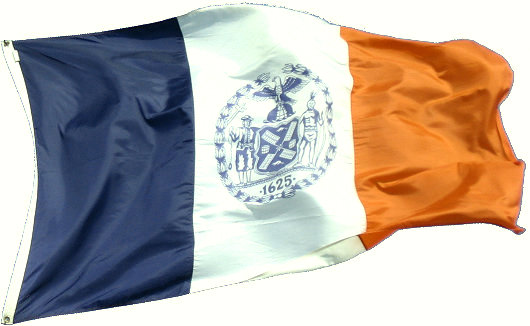
NEEDLESS TO SAY, New York owes a great deal to our Netherlandic founders, who imbued the city and land with much of its culture, eventually transformed (but not supplanted) by the overwhelming influence of the English who snuck a few warships into the harbour and knicked this land from the Hollanders. One of the many signs of New York’s Dutch history are the numerous flags which so obviously and proudly display this heritage. Here are just a few simple notes about a few of these flags.
The City of New York
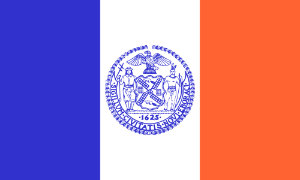 The first and most obvious, as well as most prominent, of New York’s Dutch flags is the flag of the City of New York itself. The flag of three equal bars of blue, white, and orange, with the civic seal in the center, was officially adopted in 1915. The seal, adopted in 1686, depicts the city’s coat of arms, the scrolled legend “SIGILLUM CIVITATIS NOVI EBORACI” or Seal of the City of New York, and the date of foundation, all wrapped within a laurel wreath. Originally, the city seal included the year 1664, the year the Duke of York (later James II, our last Catholic king) seized New Amsterdam from the Dutch.
The first and most obvious, as well as most prominent, of New York’s Dutch flags is the flag of the City of New York itself. The flag of three equal bars of blue, white, and orange, with the civic seal in the center, was officially adopted in 1915. The seal, adopted in 1686, depicts the city’s coat of arms, the scrolled legend “SIGILLUM CIVITATIS NOVI EBORACI” or Seal of the City of New York, and the date of foundation, all wrapped within a laurel wreath. Originally, the city seal included the year 1664, the year the Duke of York (later James II, our last Catholic king) seized New Amsterdam from the Dutch.
In 1975, the City Council altered the flag, changing the date from 1664 to 1625, the actual date of New York’s foundation by the Dutch. 1624/1625 is the general time of permanent settlement, but the Dutch began coming to and fro in 1609, when Henry Hudson first sailed into the great harbour. For this reason, some are acclaiming this very year, 2009, as the “four-hundredth birthday of New York”, when in fact it is only the anniversary of discovery.
The Borough of Manhattan
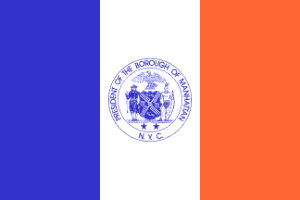 The City of New York is divided into five boroughs, the most famous and most important of which is Manhattan. Each of the five boroughs is coterminous with a county, making New York the only city in the United States that stretches over multiple counties. The Borough of Manhattan and the County of New York are one and the same geographically speaking, and the Manhattan Borough President’s office uses a flag similar to that of the city. The center white stripe displays the Borough President’s seal instead of the city seal, but as the main feature of both seals is the civic arms, the only major difference is the surrounding circle in which is written “PRESIDENT OF THE BOROUGH OF MANHATTAN – N.Y.C.”
The City of New York is divided into five boroughs, the most famous and most important of which is Manhattan. Each of the five boroughs is coterminous with a county, making New York the only city in the United States that stretches over multiple counties. The Borough of Manhattan and the County of New York are one and the same geographically speaking, and the Manhattan Borough President’s office uses a flag similar to that of the city. The center white stripe displays the Borough President’s seal instead of the city seal, but as the main feature of both seals is the civic arms, the only major difference is the surrounding circle in which is written “PRESIDENT OF THE BOROUGH OF MANHATTAN – N.Y.C.”
The Borough of Brooklyn
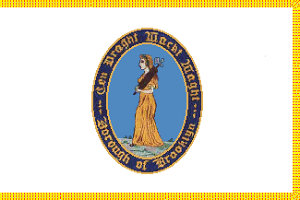 The Borough of Brooklyn sits across the East River from lower Manhattan is coterminous with King’s County (named after Charles II). Brooklyn’s flag is a simple white field with the borough’s seal, depicting “a figure of the goddess of justice in gold holding Roman fasces in her left hand set on a background of light blue”. Around this figure is the Brooklyn motto “Een Draght Mackt Maaght” (a more proper Dutch spelling would be “Eendracht maakt macht”), which means Unity makes/brings forth strength, more simply rendered as Unity is Strength. The motto has a long history, originating as the Latin phrase “Concordia res parvae crescunt”, literally translated as In harmony, the small things grow. This became the motto of the United Provinces of the Netherlands and was eventually translated into Dutch as “Eendracht maakt macht” (Unity is Strength), from whence Brooklyn got her motto.
The Borough of Brooklyn sits across the East River from lower Manhattan is coterminous with King’s County (named after Charles II). Brooklyn’s flag is a simple white field with the borough’s seal, depicting “a figure of the goddess of justice in gold holding Roman fasces in her left hand set on a background of light blue”. Around this figure is the Brooklyn motto “Een Draght Mackt Maaght” (a more proper Dutch spelling would be “Eendracht maakt macht”), which means Unity makes/brings forth strength, more simply rendered as Unity is Strength. The motto has a long history, originating as the Latin phrase “Concordia res parvae crescunt”, literally translated as In harmony, the small things grow. This became the motto of the United Provinces of the Netherlands and was eventually translated into Dutch as “Eendracht maakt macht” (Unity is Strength), from whence Brooklyn got her motto.
A South African Aside
Incidentally, it was also adopted as the motto of the ZAR, the independent Boer republic in the Transvaal. When the southern end of the continent was united in the Union of South Africa in 1910, they chose the motto “Ex Unitate Vires” or From unity, strength as a neutral alternative to having a national motto in English, Dutch, or Afrikaans. This motto was forsaken just a few years ago when the new South African government adopted the new motto of “!ke e: ǀxarra ǁke”, which is literally unpronounceable. The words mean Diverse people unite in an extinct language called ǀXam which was never widely spoken.
The Borough of the Bronx
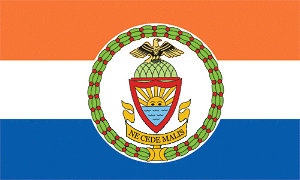 The Bronx, coterminous with Bronx County, is the only borough of New York that is part of the North American mainland. The flag, adopted in 1912, is a horizontal tricolour of orange, white, and blue, with the coat of arms of the Bronx in the center, encircled by laurels. Unlike in most American arms, the eagle on the Bronx arms faces sinister (to its left) rather than dexter (to its right). According to tradition, this was done to depict the hope of the New World looking to the Old. (Despite this, the actual law adopting the flag merely describes the crest of the arms as “Upon a hemisphere, an American eagle with wings displayed”, i.e. without giving instructions facing the eagle dexter or sinister.) The Bronx arms are supposedly derived from the arms of Jonas Bronck, the Dutchman of Danish origins who gave his name to “Bronck’s Land”, now the Bronx.
The Bronx, coterminous with Bronx County, is the only borough of New York that is part of the North American mainland. The flag, adopted in 1912, is a horizontal tricolour of orange, white, and blue, with the coat of arms of the Bronx in the center, encircled by laurels. Unlike in most American arms, the eagle on the Bronx arms faces sinister (to its left) rather than dexter (to its right). According to tradition, this was done to depict the hope of the New World looking to the Old. (Despite this, the actual law adopting the flag merely describes the crest of the arms as “Upon a hemisphere, an American eagle with wings displayed”, i.e. without giving instructions facing the eagle dexter or sinister.) The Bronx arms are supposedly derived from the arms of Jonas Bronck, the Dutchman of Danish origins who gave his name to “Bronck’s Land”, now the Bronx.
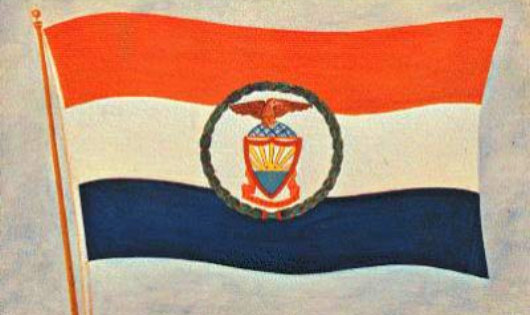
Queens Borough
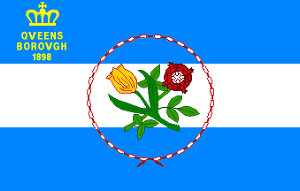 Queens takes its name from Queens County, one of the twelve original counties of New York, and was named after Catherine of Braganza, the queen of King Charles II. The flag was adopted in 1913, and the blue-white-blue comes from the arms of Willem Kieft, the sixth Dutch governor of New Netherland, known to readers of Irving by his nickname “William the Testy”. The tulip and the rose signify the Dutch and the English — the two European peoples who settled Long Island. The native inhabitants are represented by the string of wampum that encircles the flowers. The design might look more harmonious if the crown were augmented in size and the text removed entirely.
Queens takes its name from Queens County, one of the twelve original counties of New York, and was named after Catherine of Braganza, the queen of King Charles II. The flag was adopted in 1913, and the blue-white-blue comes from the arms of Willem Kieft, the sixth Dutch governor of New Netherland, known to readers of Irving by his nickname “William the Testy”. The tulip and the rose signify the Dutch and the English — the two European peoples who settled Long Island. The native inhabitants are represented by the string of wampum that encircles the flowers. The design might look more harmonious if the crown were augmented in size and the text removed entirely.
The County of Westchester
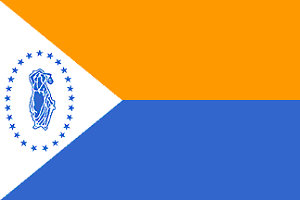 Westchester’s flag uniquely displays the Dutch colours orange over blue, with a white triangle emanating from the hoist. The flag was adopted only in 1939, so that our fair county could fly a flag of its own from the Westchester exhibition at the New York World’s Fair that year. (I have at home my grandfather’s guide book, with notes and ticks indicating which pavilions were visited). The figure of Justice comes from the county seal (which I, and many other Westchesterites, most often see in the safety inspection stickers on gas tanks I stare at while filling the car with gas), while the number of stars encircling her is equal to the number of municipalities in the county. A 1985 enactment added the words “Westchester County, New York” to the blue bar, but (happily) this innovation is not universally in force.
Westchester’s flag uniquely displays the Dutch colours orange over blue, with a white triangle emanating from the hoist. The flag was adopted only in 1939, so that our fair county could fly a flag of its own from the Westchester exhibition at the New York World’s Fair that year. (I have at home my grandfather’s guide book, with notes and ticks indicating which pavilions were visited). The figure of Justice comes from the county seal (which I, and many other Westchesterites, most often see in the safety inspection stickers on gas tanks I stare at while filling the car with gas), while the number of stars encircling her is equal to the number of municipalities in the county. A 1985 enactment added the words “Westchester County, New York” to the blue bar, but (happily) this innovation is not universally in force.
The City of Albany
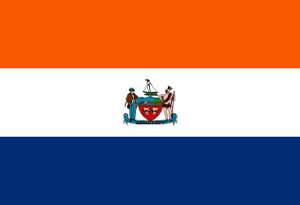 Albany was founded as the trading post of Fort Orange in 1624, and surrendered to the English sixteen days after they took New Amsterdam in 1664. It received its current name after the Scottish title of the future King James VII & II as Duke of Albany, just as New York was named after his English title of Duke of York. It was the second city in the Province of New York, receiving its charter from Governor Dongan just three months after the City of New York. Albany’s flag, adopted in 1909, is a Dutch tricolour with the city’s coat of arms displayed in the center. During the jingoistic days of the First World War, an alderman proposed changing the colours of the flag to the “American” red, white, and blue, but the mayor of the day vetoed the idea.
Albany was founded as the trading post of Fort Orange in 1624, and surrendered to the English sixteen days after they took New Amsterdam in 1664. It received its current name after the Scottish title of the future King James VII & II as Duke of Albany, just as New York was named after his English title of Duke of York. It was the second city in the Province of New York, receiving its charter from Governor Dongan just three months after the City of New York. Albany’s flag, adopted in 1909, is a Dutch tricolour with the city’s coat of arms displayed in the center. During the jingoistic days of the First World War, an alderman proposed changing the colours of the flag to the “American” red, white, and blue, but the mayor of the day vetoed the idea.
The County of Nassau
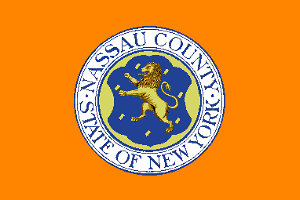 When the five boroughs of New York City were amalgamated in 1898, over seventy percent of Queens County remained outside the city boundaries. These parts were combined into a county of their own in 1899, which required a name of its own. “Matinecock” was suggested, after a village in the new county; “Sagamore” was another, after the splendid Oyster Bay home of the then-governor Theodore Roosevelt; “Norfolk” was a third proposal, because Suffolk County borders to the east. Eventually, however, the name of Nassau was settled upon. Not only the name of the Dutch ruling house, but Long Island was once known as Nassau to the Dutch, and it was decided to revive a previous name rather than to invent a new one.
When the five boroughs of New York City were amalgamated in 1898, over seventy percent of Queens County remained outside the city boundaries. These parts were combined into a county of their own in 1899, which required a name of its own. “Matinecock” was suggested, after a village in the new county; “Sagamore” was another, after the splendid Oyster Bay home of the then-governor Theodore Roosevelt; “Norfolk” was a third proposal, because Suffolk County borders to the east. Eventually, however, the name of Nassau was settled upon. Not only the name of the Dutch ruling house, but Long Island was once known as Nassau to the Dutch, and it was decided to revive a previous name rather than to invent a new one.
The Nassau flag features the county seal on a field of orange. The seal is composed of the arms of the House of Nassau within an encircling ring bearing the legend “Nassau County — State of New York”.
Orange County
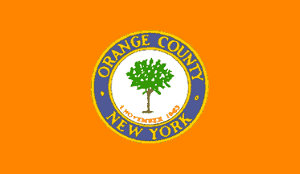 Orange County was one of the original twelve established in 1683, and proudly displays its date of erection on the county seal. Like that of Nassau, the flag simply depicts the county seal — primarily an orange tree — on a field of orange. Orange County, like every other Orange thing in New York, takes its name from the House of Orange-Nassau, the royal house of the Netherlands. Its county seat was originally Orangetown, the southernmost municipality, but Orangetown and four other towns formed the separate county of Rockland in 1798.
Orange County was one of the original twelve established in 1683, and proudly displays its date of erection on the county seal. Like that of Nassau, the flag simply depicts the county seal — primarily an orange tree — on a field of orange. Orange County, like every other Orange thing in New York, takes its name from the House of Orange-Nassau, the royal house of the Netherlands. Its county seat was originally Orangetown, the southernmost municipality, but Orangetown and four other towns formed the separate county of Rockland in 1798.
Search
Instagram: @andcusack
Click here for my Instagram photos.Most Recent Posts
- Faithful Shepherd of the Falklands April 8, 2025
- Articles of Note: 8 April 2025 April 8, 2025
- Proportionality Destroys Representation April 8, 2025
- Sag Harbor Cinema March 26, 2025
- Teutonic Takeover March 10, 2025
Most Recent Comments
Book Wishlist
Monthly Archives
Categories



Unfortunately today the colour combination orange-white-blue (,,oranje-blanje-bleu”) brings the extreme right to the mind of a Dutchman, as the national colours are fixed at red-white-blue. Which, it must be admitted, in an American context, would not be really destinguishable from American symbolism.
Flags are such fun, aren’t they?
Do the Dutch still add an orange pennant above the flag to honor the House of Orange?
And, are you sure that NYC is the only city to stretch over multiple counties? I know of some cities that stretch into at least two counties….
On the subject of NYC’s founding and World’s Fairs, I propose that the city should apply to host the 2024 World’s Fair to coincide with it’s 400th birthday.
Springdale, Ar (home of Tyson Foods) stretches over both Washington and Benton counties.
Bella Vista, AR is a tad more ambitious, seeking to extend over state lines. They want to annex a small amount of MO in order to sale cigarettes without paying AR taxes.
Someone with poor eyesight might mistake the Westchester flag for the Czech flag (hell, maybe even the Philippine flag!).
Personally, though, IMHO, the Westchester flag has a nice… character. (If the State o New York ever decides to change its flag, maybe inspiration could be taken from Westchester. [Maybe….])
Correction: Jonas Jonasson Bronck was Swedish-born, not Danish, as indicated by documents he signed in Amsterdam. The patrinym “Jonasson” further refutes the old Danish claim.
Mr Cusack,
Kansas City, MO encompasses parts of four separate counties and Lake Quivira, KS (pop. ca. 950) is in both Wyandotte and Johnson Counties.
‘Cusack’? ‘Scotland’? Enough to explain for the strident anti-English tome of the piece at any rate, and the lie of a ‘motherland’ bringing a ‘love of freedom’ they presumably lost soon after the wicked Anglos ‘snuck’ (it’s sneaked) ‘a few warships’ (is that really all it took?) into the area. Irish and Scots, known liars and unable to build civilisations of their own, invariably rely on the English to provide them with a start in life and of course indebtedness does breed resentment. All the same you should give the egalitarian show of solidarity a rest and realise the world’s dross – parasitic Irish excluded naturally – continues to fetch up in America in this day precisely because of attitudes like this. Ho hum.
But, dear Robin Goodfellow, how then do you explain the equally disastrous “fetching-up” on English shores of the “world’s dross”?
If not that same “egalitarian show of solidarity” then what?